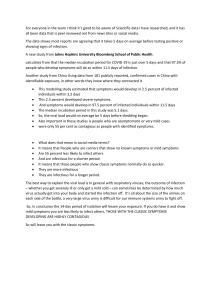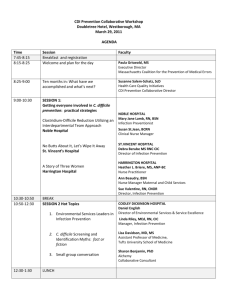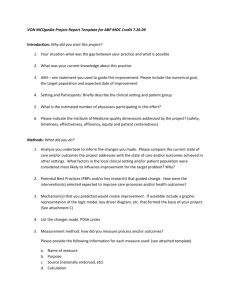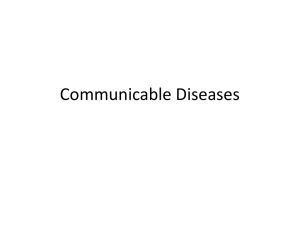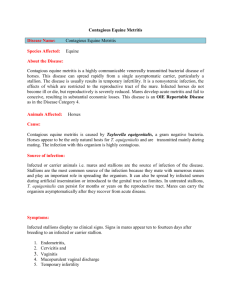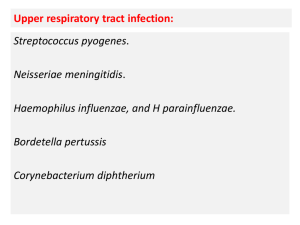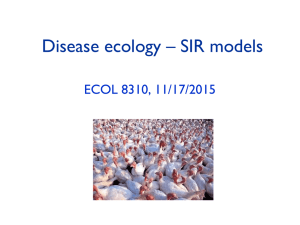- كلية الطب البيطري
advertisement
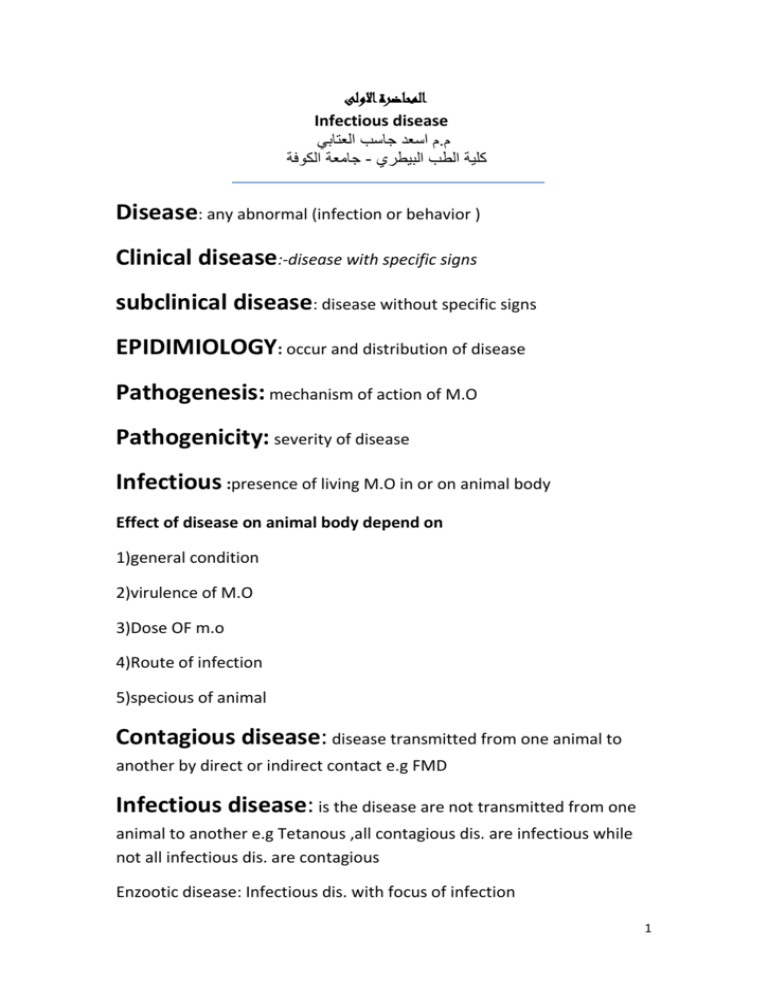
المحاضرة االولى Infectious disease م اسعد جاسب العتابي.م جامعة الكوفة- كلية الطب البيطري Disease: any abnormal (infection or behavior ) Clinical disease:-disease with specific signs subclinical disease: disease without specific signs EPIDIMIOLOGY: occur and distribution of disease Pathogenesis: mechanism of action of M.O Pathogenicity: severity of disease Infectious :presence of living M.O in or on animal body Effect of disease on animal body depend on 1)general condition 2)virulence of M.O 3)Dose OF m.o 4)Route of infection 5)specious of animal Contagious disease: disease transmitted from one animal to another by direct or indirect contact e.g FMD Infectious disease: is the disease are not transmitted from one animal to another e.g Tetanous ,all contagious dis. are infectious while not all infectious dis. are contagious Enzootic disease: Infectious dis. with focus of infection 1 Epizootic disease: wide distributed contagions disease Morbidity rate= No.of affected/Population*100 Mortality rate= No.of death/Population*100 EQUINE DISEASE Strangles EQUINE DISTEMPER Definition It is an acute highly contagious Disease of horse characterized by inflammation of upper Respiratory tract and abcessation of regional Lymph nodes. Etiology Streptococcus equi Epidemiology It is worldwide in distribution ,the predisposing factor include :1)cold weather, crowding , and transport animals. 2) Streptococcus equi is very resistant bacteria may stay several weeks or months. 3)the bacteria can persist living in the pharynx of normal horse for 8 monthes Death is due to extention of infection to other organs and complication Sourse of infection Nasal discharge of infected animals Transmition By Inhalation of an infected droplet and by ingested of contaminated food and water 2 Immunity Strong immunity after infection and the Ab pass through the colostrum to the foals and give protection for first month. Pathogenesis After infection the M.O go to nasopharynx there is colonization and multiplication Adhesion to epithelial cells Pharyngitis Drainage to reginal L.N and abcessation Clinical Signs 1)the incubation period 4-8 days 2)there is depression, anorexia, and fever for 39.5-40 3)nasal discharge then become copious and purulent 4)difficult in swallowing and regurgitation from the nostril 5)there are moist soft cough and painful 6)swelling and abcessation of submandibular L.N ,then rupture with thick creamy pus . Complication of disease The complication occur duo to metastasis of infection to other organs 1)purpura hemorrhagica 3 2)Guttural pouch infection 3)acute pneumonia 4)purulent meningitis 5)Abscess in spleen,liver, and lung 6)cardiac ditrerbance D.Diagnosis 1)Equine viral Rhinopneomonitis 2)= = arteritis. 3) Equine influenza 4)infection with streptococcus zooepidermicus 5)Infection with streptococcus fecalis 6)Rhino virus 7)Adenovirus 8)Guttural pouch disease Diagnosis 1)History and clinical signs 2)Clinical pathology a)nasal swab,swab from abscess b)serology . serum for haemagglotination test c)haematology .blood sample: leukocytosis and neotropenia anemia duo to hemolytic effect of streptococcus and toxin production 3)necropsy finding. Suppuration in liver,spleen, and lung plural 4 Treatment 1)Specific treatment. Sigle I.V ingection of Benzyl penicillin G in a dose 44000 i.u /kg BW Procaine benzyle pencillin in a dose of 22000 i.u /kg BW Twise daily for 5 dayes 2)General treatment Soft diet ,keep the nostril and muscle clean and surgical tr. Using poviodine. Control 1)Isolation of infected animals 2)cleaning and disinfectant 3)emergency profilacting tr. For foals using Benzyl penicillin 4)quarantine for all infected horse 5)vaccination a)commers kill vaccine b) commers autogenous vaccine c)intranasal vaccine 5
